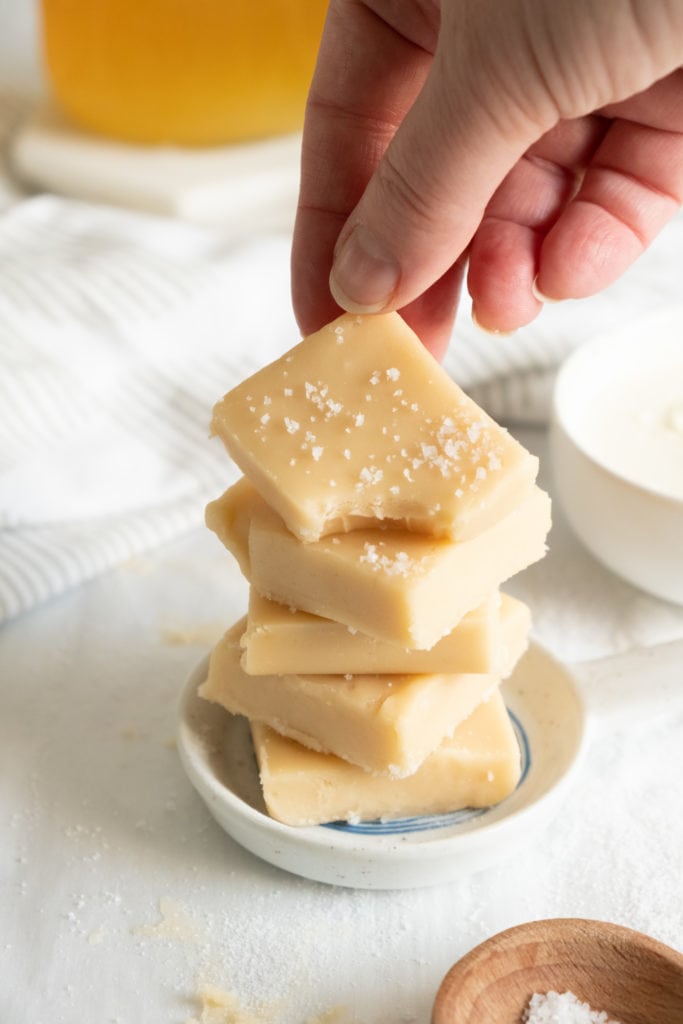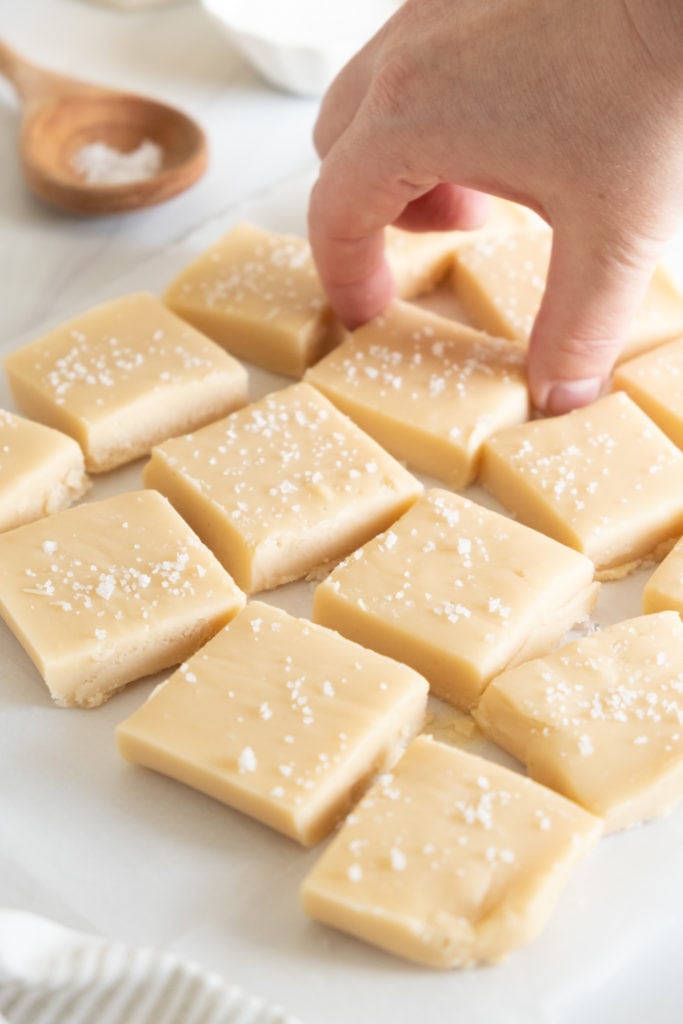How Long Does Fudge Last? Your Fudge FAQ Answered
This article may contain affiliate links. See our disclosure link for more information.
How long does fudge last? Can you freeze it? What’s the best way to store it? All of your fudge FAQ (and a recipe) are in this guide!
Contents
- 1 What Is Fudge?
- 2 What Ingredients Do I Need to Make Fudge?
- 3 How To Make Fudge?
- 4 How Long Will Fudge Last?
- 5 Can I Store Leftover Fudge At Room Temperature?
- 6 What’s The Best Way to Store Fresh Fudge?
- 7 How to Store Fudge in Hot Climates
- 8 Can I Freeze Fudge?
- 9 How Will I Know If My Fudge Has Gone Bad?
- 10 Ready to Make Homemade Fudge?
What Is Fudge?
Fudge is a type of no bake candy treat that may or may not chocolate. Depending on the flavor, fudge can contain add-ins such as chocolate chips, nuts, peanut butter or flavors like coffee or mint.
Some popular fudge flavors include rocky road fudge, red velvet fudge, gingerbread fudge, M&M fudge, S’mores fudge, peanut butter fudge and my favorite fudge recipe…Clotted Cream Fudge.
Like most sweet treats, you can either buy fudge at a grocery or candy store or make it at home. To make fudge at home, you will need just a few basic ingredients and any mix-ins you want to add. Since fudge is typically very sweet, cut and serve your fudge in small bite-sized pieces.

What Ingredients Do I Need to Make Fudge?
There are different types of fudge, recipes, and ways to make fudge. Some recipes call for sweetened condensed milk, butter, and chocolate chips, while others use sugar, butter, milk, and either chocolate chips or cocoa powder.
Fudge recipes that aren’t chocolate-based, like my Clotted Cream Fudge use ingredients like sugar, golden syrup, and clotted cream (instead of butter).
For extra flavor, you can also add vanilla extract (or other extracts) and a pinch of salt to your fudge. And then, of course, you can add all of your favorite specific add-ins (e.g. nuts, marshmallows, pretzels, peanut butter, etc) or toppings (like fleur-de-sel…yum).
How To Make Fudge?
The easiest way to make fudge is to melt sweetened condensed milk, butter, and chocolate chips on the stove or in the microwave, add mix-ins, and then pour into a lined shallow dish (typically 8×8) to cool and set.
You can also make fudge by cooking the sugar, butter, milk and chocolate or cocoa powder in a saucepan to the soft ball stage. This is when the mixture is between 234 to 240 F in temperature. You can test if it’s at the soft ball stage by dropping a small spoonful of the mixture in cold water and see if it forms a ball you can squish with your fingers.
The next step is to take the fudge mixture off the heat and stir, stir, stir until it cools, thickens, and becomes matte. This can take several minutes. Once the mixture has cooled, pour into a shallow pan to set before cutting into individual pieces.
As the success of making the second type of fudge is dependent on the temperature of the dissolved sugar, it is imperative that a candy thermometer is used during the cooking process. I love and use this one.
How Long Will Fudge Last?
Because of the high sugar content in fudge it has a long shelf life compared to other types of desserts/sweets.
Store bought fudge tends to last longer than homemade fudge since it contains preservatives. However, to be sure you’re eating the best quality fudge, err on the side of caution and read the packaging on the fudge for guidance as to how long the fudge will last.
Generally, fresh fudge, when stored correctly in a sealed container, will keep for 1-2 weeks at room temperature.
Can I Store Leftover Fudge At Room Temperature?
Yes! Fresh fudge is best stored at room temperature. To ensure your fudge is at best quality, it’s important to store the fudge in a cool, dark, dry place like a kitchen cupboard or pantry. Don’t just leave fudge on a plate on your counter! Room temperature fudge will keep for a couple weeks.
Similar to homemade fudge, fudge from a candy store can be stored at room temperature. It is usually fine to leave it in the packaging it came in. Read the packaging instructions for guidance as to how long you can store the fudge at room temperature.
What’s The Best Way to Store Fresh Fudge?
The best way to store fudge is at room temperature. Refrigeration will draw out the moisture from the fudge, causing it to be dry and crumbly. To retain the quality of the fudge, place fresh fudge into a sealed, air-tight container.
If the fudge is in larger blocks, cut it up into smaller pieces before storing. For an extra layer of protection, wrap the fudge in some wax paper before storing. Fudge should be stored in a dry, dark, and cool area away from direct sunlight, like a cupboard or pantry, and not on your kitchen counter.
If you need to store your fudge for much longer, freezing is a great option. To properly store fudge in the freezer, first double wrap it with wax paper or parchment paper and then with either aluminum foil or plastic wrap. Place the double wrapped fudge in a freezer bag or airtight container before placing in the freezer.
How to Store Fudge in Hot Climates
Storing fresh fudge in hot climates or high humidity requires slightly different storage tips due to excess moisture in the air. If you don’t have a cool, dry place to store your fudge, it’s better to keep it in the fridge or freezer.
Leaving fudge out in hot temperatures or high humidity could cause the fudge to melt or change texture. Remember to double wrap the fudge in wax or parchment paper and place in a good airtight container.
Can I Freeze Fudge?
Yes. Fudge can be frozen and most fudge recipes will freeze and thaw well. The texture of the fudge matters here; fudge with a denser texture tends to freeze better than fudge with a lighter texture. Freezing fudge can be a good option for long term storage as opposed to refrigeration.
To prepare the fudge for the freezing process, first double wrap the fudge with wax/parchment paper and aluminum foil or plastic wrap. To prevent ruining the fudge from freezer burn, place the fudge in a freezer container or in a freezer bag. This is much better than placing the fudge in the freezer with just foil or plastic wrap.
If you’re using a container to store your fudge, make sure the container is able to provide protection against the absorption of odors and flavors (same goes for fridge storage). It’s also best to store the fudge cut into smaller pieces and individually wrapped so you don’t have to defrost all the fudge at once and can keep the remaining in the freezer for later.
To thaw the fudge, place in the fridge to thaw. This allows the fudge to thaw at a controlled temperature. Allow for some time for the fudge to rest before serving, anywhere between 10 minutes and 2 hours.

How Will I Know If My Fudge Has Gone Bad?
The shelf life of your fudge will depend on whether it is homemade or store-bought. To know if your store bought fudge has gone bad, a good indicator would be the expiration date on the packaging. It is always best to go by this indicator even if there are no visible signs of spoilage yet.
For homemade fudge, you can look for obvious clues – one of them being the texture of the fudge. If the fudge has been exposed to air, the surface will dry out and begin to crack. If you see deep cracks on the surface of the fudge, it is old and should not be consumed.
In the case where the fudge experiences a change in temperature or is exposed to warm temperatures or high humidity, it can melt or have a slimy texture. If this is the case, it’s better to play it safe and should not be consumed. Also, the addition of some extra ingredients may mean the fudge can begin to grow mold or show signs of other bacterial growth. If there is any type of growth on your fudge, do not consume to prevent food poisoning.
Ready to Make Homemade Fudge?
Great! I highly recommend making this Clotted Cream Fudge – it’s divine! And perfect for those who want to break out of the chocolate fudge rut. It’s easy to make on the stove using a candy thermometer. I like to sprinkle a little fleur-de-sel on the top once it’s cooled as a contrast to the sweetness and for a little crunch. Enjoy!






